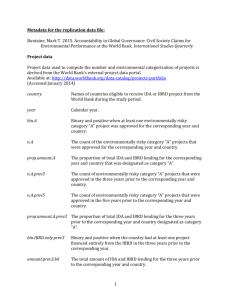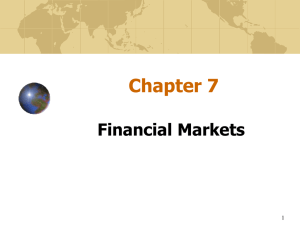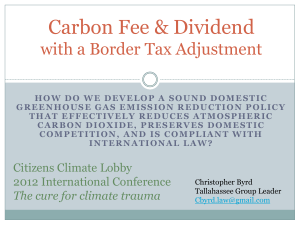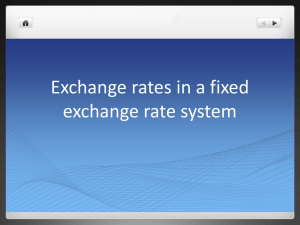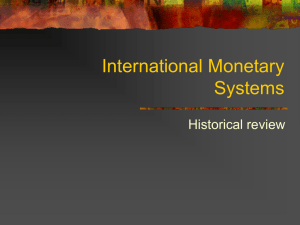File
advertisement
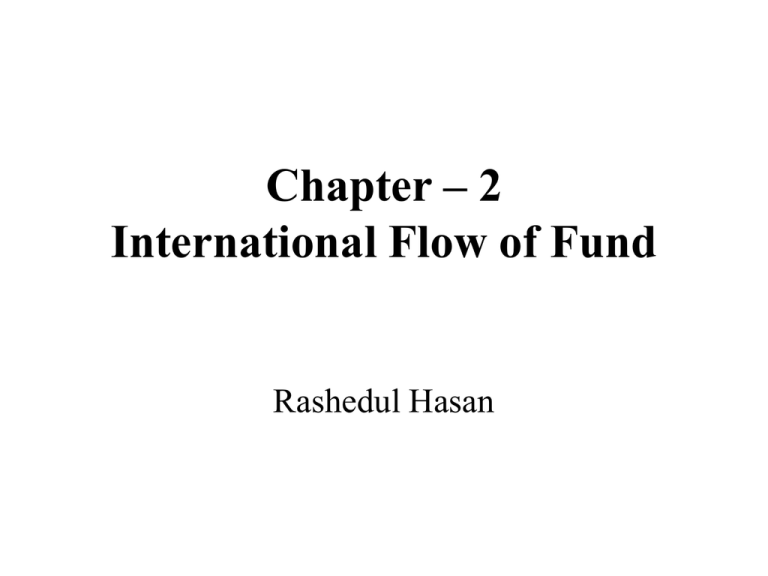
Chapter – 2 International Flow of Fund Rashedul Hasan Balance of Payments • The balance of payments is a measurement of all transactions between domestic and foreign residents over a specified period of time. It represents an accounting of a country’s international transactions for a period. Each transaction is recorded as both a credit and a debit, i.e. double-entry bookkeeping. Balance of Payments The balance of payments statement can be broken down and are presented in three groups – – A current account, – A capital account – A financial account A current account • A key component of the current account is the balance of trade, which is simply the difference between export and Import. Therefore the current account summarizes the flow of funds between one specified country and all other countries due to the purchases of goods or services, the provision of income on financial assets (factor income-interest, dividend), or unilateral current transfers (e.g. government grants and pensions, private remittances). • A current account deficit suggests a greater outflow of funds from the specified country for its current transactions. Simply it means the value of goods and services exported by a country is less than the value of goods and services imported by that country. Summary of U.S. International Transactions (For the Year of 2000 in Millions of Dollars) Current Account Exports of goods and services and income receipts 1418568 Goods, balance of payments basis 772210 Services 293492 Income receipts 352866 Imports of goods and services and income receipts -1809099 Goods, balance of payments basis -1224417 Services -217024 Income payments -367658 Unilateral current transfers, net -54136 Balance on current account -444667 The current account is commonly used to assess the balance of trade, which is simply the difference between merchandise exports and merchandise imports. Capital account • The key components of the capital account are Direct Foreign Investment. DFI represents the investment in fixed asset in foreign countries that can be used to conduct the business operation. Another two important components are Portfolio investment and other capital investment. Portfolio investment represent transaction involve in Long-term assets (stocks, bonds) on the other hand, other capital investment represent transaction involve in Short-term asset (money market securities). The capital account represents a summary of the flow of funds resulting from sales of asset between one country and all other countries over a specified period of time. It includes, debt forgiveness, transfers by immigrants, the sale or purchase of rights to natural resources or patents. Financial account • The financial account (which was called the capital account previously) summarizes the flow of funds resulting from the sale of assets between one specified country and all other countries. • Assets include official reserves, other government assets, direct foreign investments, investments in securities, etc. International Trade Flows • For most of the countries, the volume of trade is growing. For example, Canada’s trade volume of exports and imports per year is valued at more than 50% of it annual GDP. Recent Changes in European Trade • The Single European Act of 1987 was implemented to remove explicit and implicit trade barriers among European countries. Consumers in Eastern Europe now have more freedom to purchase imported goods. The single currency system implemented in 1999 eliminated the need to convert currencies among participating countries. Trade Agreements Around the World In 1993, a General Agreement on Tariffs and Trade (GATT) accord calling for lower tariffs was made among 117 countries. Other trade agreements include: • Association of Southeast Asian Nations • European Community • Central American Common Market • North American Free Trade Agreement Friction Surrounding Trade Agreements Trade agreements are sometimes broken when one country is harmed by another country’s actions. • Dumping refers to the exporting of products by one country to other countries at prices below cost. • Another situation that can break a trade agreement is copyright piracy. Factors Affecting International Trade Flows • Inflation • If country’s inflation rate increases relative to the countries with which it trades, its current account will be expected to decrease, other things being equal. Consumers in that country will prefer to purchase more foreign goods due to high local inflation, while the country’s export will decline. • Therefore, A relative increase in a country’s inflation rate will decrease its current account, as imports increase and exports decrease. Factors Affecting International Trade Flows • National Income • If country’s income level increases by a higher percentage, its current account will be expected to decrease, other things being equal. With the increasing income level, the consumption of goods also increases. A percentage of that increase in consumption will most likely reflect an increased demand for foreign goods. • Therefore, A relative increase in a country’s income level will decrease its current account, as imports increase. Factors Affecting International Trade Flows • Exchange Rates • Each country’s currency is valued in terms of other country’s currencies through the use of exchange rate. The value of most currencies can fluctuate over time because of market and Govt. forces. If a country’s currency begins to rise in value, its current account balance will decrease as imports increase and exports decrease. As the currency strengthens, goods exported by that country would become more expensive to the importing country. As a result, the demand for such goods will decrease. Factors Affecting International Trade Flows Exchange Rates • For example, A computer that sales in U.S. market for $ 100 will require a payment of C$ 125 by the Canadian importer if the Canadian dollar is valued at C$ 1=$0.80. Now if C$ 1=$0.70, it would requires a payment of C$ 143, which might discourage the Canadian demand for U.S. computer. • Therefore, A strong local currency is expected to reduce the current account balance. Factors Affecting International Trade Flows • Government Restrictions A government may reduce its country’s imports by imposing tariffs on imported goods, or by enforcing a quota. Other countries may retaliate by imposing their own trade restrictions. Sometimes though, trade restrictions may be imposed on certain products for health and safety reasons. Factors Affecting International Trade Flows • Government Restrictions • Tariffs and Quota • If a country’s Govt. imposes a tax on imported goods, which is referred to as Tariffs, the price of the foreign goods can increase drastically. • In addition to tariff, the Govt. can reduce its country’s import by enforcing a Quota or maximum limit that can be imported. Correcting A Balance of Trade Deficit • By reconsidering the factors that affect the balance of trade, some common correction methods can be developed. • For example, a floating exchange rate system may correct a trade imbalance automatically since the trade imbalance will affect the demand and supply of the currencies involved. Why a Weak home currency is not a perfect solution • Counter pricing by competitors A weak home currency may not necessarily improve a trade deficit. When a country’s currency weaken, its prices become more attractive to foreign customer, and many foreign companies may lower their prices to maintain their competitiveness. • Impact of other Weak currencies The currency does not necessarily weaken against all currencies at the same time. Why a Weak home currency is not a perfect solution • Pre-arranged international transactions Many trade transactions are pre-arranged and cannot be adjusted immediately. • Inter company trade The impact of exchange rate movements on intracompany trade is limited. Many firms buy products that are produced by their subsidiaries, what is referred to as intra-company trade. This type of trade makes up more than 50% of all International Trade. The intra-company trade continues regardless of exchange rate movement. Factors Affecting DFI • Changes in Restrictions New opportunities may arise from the removal of government barriers. • Privatization DFI has also been stimulated by the selling of government operations. • Potential Economic Growth Countries with higher potential economic growth are more likely to attract DFI. • Tax Rates Countries that impose relatively low tax rates on corporate earnings are more likely to attract DFI. • Exchange Rates Firms will typically prefer to invest their funds in a country when that country’s currency is expected to strengthen. Factors Affecting International Portfolio Investment • Tax Rates on Interest or Dividends Investors will normally prefer countries where the tax rates are relatively low. • Interest Rates Money tends to flow to countries with high interest rates. • Exchange Rates Foreign investors may be attracted if the local currency is expected to strengthen. Agencies that Facilitate International Flows • • • • International Monetary Fund (IMF) World Bank Group World Trade Organization (WTO) Bank for International Settlements (BIS) International Monetary Fund (IMF) • The IMF is an organization of 183 member countries. Established in 1946, it aims • To promote international monetary cooperation and exchange stability; • To foster economic growth and high levels of employment; • To provide temporary financial assistance to help ease imbalances of payments • In particular, its compensatory financing facility attempts to reduce the impact of export instability on country economies. • You may learn more about the IMF at http://www.imf.org. World Bank Group • Established in 1944, the Group assists development with the primary focus of helping the poorest people and the poorest countries. It has 183 member countries, and is composed of five organizations - IBRD, IDA, IFC, MIGA and ICSID. IBRD: International Bank for Reconstruction and Development • Better known as the World Bank, the IBRD provides loans and development assistance to middle-income countries and creditworthy poorer countries. • In particular, its structural adjustment loans are intended to enhance a country’s long-term economic growth. It may spread its funds by entering into co-financing agreements with official aid agencies, export credit agencies, as well as commercial banks. IDA: International Development Association • IDA was set up in 1960 as an agency that lends to the very poor developing nations on highly concessional terms. IDA lends only to those countries that lack the financial ability to borrow from IBRD. IBRD and IDA are run on the same lines, sharing the same staff, headquarters and project evaluation standards. IFC: International Finance Corporation • The IFC was set up in 1956 to promote sustainable private sector investment in developing countries, by financing private sector projects; helping to mobilize financing in the international financial markets; and providing advice and technical assistance to businesses and governments. M IGA: Multilateral Investment Guarantee Agency The MIGA was created in 1988 to promote FDI in emerging economies, by offering political risk insurance to investors and lenders; and helping developing countries attract and retain private investment. ICSID: International Center for Settlement of Investment Disputes The ICSID was created in 1966 to facilitate the settlement of investment disputes between governments and foreign investors, thereby helping to promote increased flows of international investment. • To learn more about the World Bank Group and its organizations, visit: • http://www.worldbank.org • http://www.worldbank.org/ibrd • http://www.worldbank.org/ida • http://www.ifc.org • http://www.miga.org • http://www.worldbank.org/icsid World Trade Organization (WTO) Created in 1995, the WTO is the successor to the General Agreement on Tariffs and Trade (GATT). It deals with the global rules of trade between nations to ensure that trade flows smoothly, predictably and freely. At the heart of the WTO's multilateral trading system are its trade agreements. Its functions include: • • • • • • Administering WTO trade agreements; Serving as a forum for trade negotiations; Handling trade disputes; Monitoring national trading policies; Providing technical assistance and training for developing countries; and Cooperating with other international groups. Bank for International Settlements (BIS) Set up in 1930, the BIS are an international organization that fosters cooperation among central banks and other agencies in pursuit of monetary and financial stability. It is the “central banks’ of “central bank” and “lender of last resort.” The BIS functions as: 1. A forum for international monetary and financial cooperation; 2. A bank for central banks; 3. A center for monetary and economic research; and 4. An agent or trustee in connection with international financial operations. To learn more about the WTO and the BIS, visit: • http://www.wto.org • http://www.bis.org Regional Development Agencies Agencies with more regional objectives relating to economic development include • The Inter-American Development Bank; • The Asian Development Bank; • The African Development Bank; and • The European Bank for Reconstruction and Development. Check out the following regional agencies: • Inter-American Development Bank: http://www.iadb.org • Asian Development Bank: http://www.adb.org • African Development Bank: http://www.afdb.org • European Bank for Reconstruction and Development: http://www.ebrd.com




